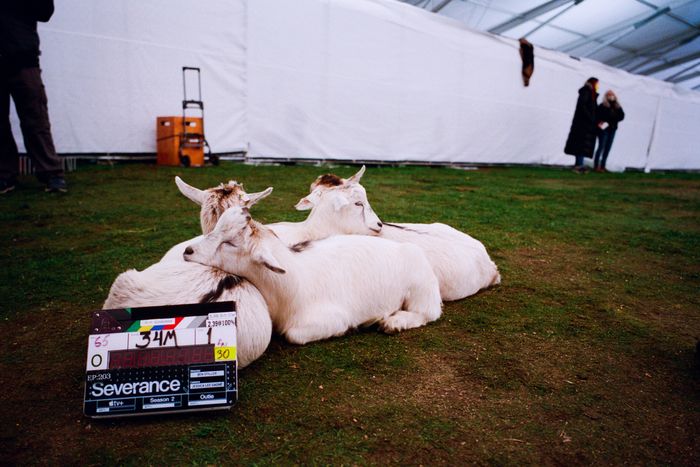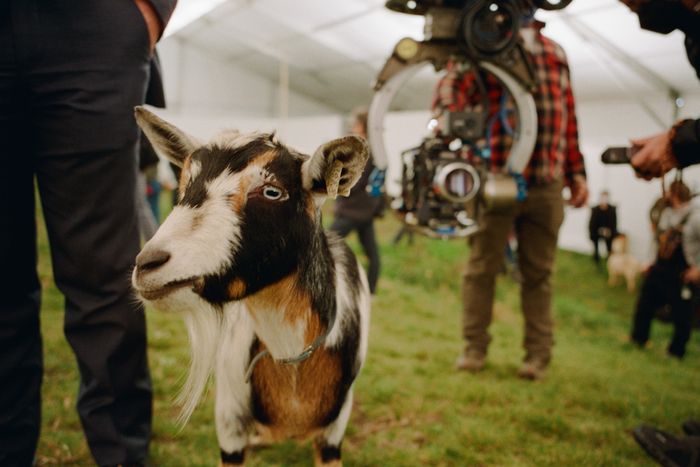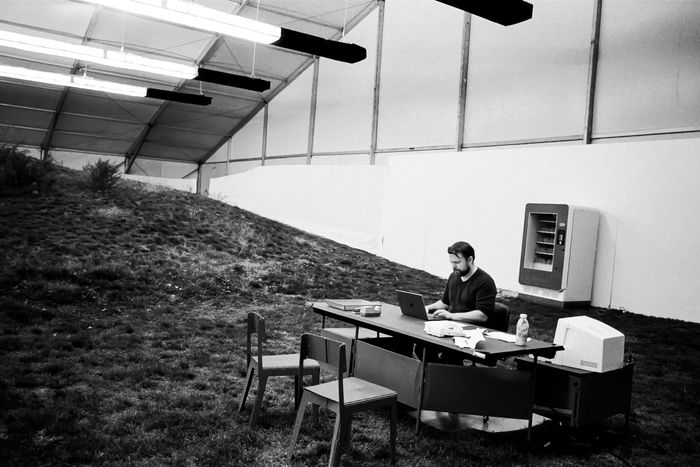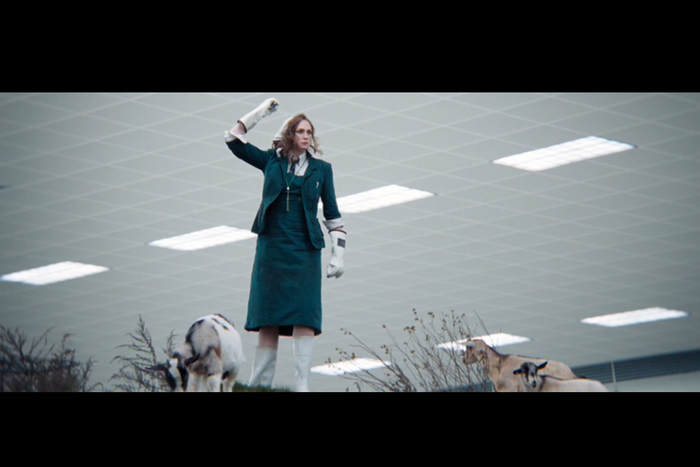
Severance brought 50-some goats to a golf course in Brooklyn to create its Department of Mammalian Nurturability.
Photo: Ben Stiller
Spoilers follow for Severance season two, episode three, “Who Is Alive?”
Goats have been central to Lumon lore since the early days of Severance season one. Mark and Helly, drawn to the wails of what sounds like an infant, open a door inside the Lumon complex and discover an all-white room with baby goats frolicking on bales of hay and one being bottle-fed by a man in a suit. “You can’t take them yet,” the man says frantically. “They’re not ready. It isn’t time.” Then he yells at Mark and Helly to “get the hell out of here,” which they do. Severance being Severance, a series that revels in the unexplained, the goats’ purpose is not addressed for the rest of the season. But it seemed fair to assume they would show up again.
The season-two episode “Who Is Alive?” delivers on that hunch in spectacularly weird fashion. Fearing that Ms. Casey/Gemma is trapped somewhere in Lumon’s walls, Mark (Adam Scott) and Helly (Britt Lower) return to the goat room and discover a tunnel in the wall that leads to an enormous indoor annex with grassy, rolling hills and more roaming goats. They’re supervised by a suspicious woman named Lorne (Gwendoline Christie) and her staff of primitively attired goat herders and caretakers. The name of this odd, presumably heinous-smelling place: the Department of Mammalian Nurturability.
Severance is filled with bizarre and arresting imagery, but this new, expanded view of the goat room takes things to a level that required more imagination than usual from the creative team. “I don’t think there was anything in the world that looked like the goat room,” says Severance creator Dan Erickson. “We had to make it out of whole cloth.” Here, he and his colleagues answer our most urgent questions about “goat central.”
“We always knew there was a larger goat central,” says Erickson, “but we figured out the exact geography while writing it and designing it.”
While brainstorming how to design the goat’s living quarters, Erickson, along with EP and director Ben Stiller and production designer Jeremy Hindle, noticed there was a corner of the initial goat room that never appeared on-camera. It sparked the idea of putting a tunnel in that wall — just tall enough to accommodate your average goat — which would connect to what Hindle envisioned as a much vaster area where the goats could roam (sort of) freely. “I kept saying, ‘Guys, it’s going to be massive,’” Hindle says. He wanted to create an area that felt even more all-encompassing than the seemingly endless Optics and Design Department from the first season. He succeeded on that front: The design and eventual build of the set measured 240 feet long by 120 feet wide, the equivalent of more than half an acre.
Hindle also felt strongly about having real fields of grass on set, which presented some challenges. “I wanted rolling hills that were really natural, that were organic and not fake-looking, the way they would be if I made them,” he says. “We knew we didn’t have the resources to build that on a stage,” Stiller adds. “It would be too expensive, especially for the scale we felt that we needed.” The team had to come up with another solution.
Hindle came up with the idea to build the set on a section of a golf course that matched the gently hilly landscape he envisioned. The crew explored multiple locations, eventually landing on the Marine Park course in Brooklyn. “We built the walls of the room around it on a big, wide piece of grass,” Hindle explains. Above the 15-foot-high walls, they added a huge tent to shield the set from the elements (it rained during the shoot). Postproduction added visual effects to essentially erase the tent and render an even higher ceiling with walls seamlessly connecting to it. As simple as that might sound, the process required intense attention to CGI detail, with effects house Industrial Light & Magic brought in to help with the intricate work. “That set honestly took months,” says Lindle. “That’s really the biggest reason we went to ILM, was to do sets like that.”
Visual effects also adjusted lighting and color and in some cases moved the positions of the goats, who are notoriously hard to direct. “We change their direction. We change their color. We paint them out,” says Hindle. “Half the goats are in different places by the time we’re done. But we need them there to interact with Gwendoline. You need them with the other actors.”
Filming had to coordinate around the kids’ schedules: “We need baby goats, and baby goats are not born that often,” says production designer Jeremy Hindle.
Photo: Ben Stiller
Stiller and Hindle estimate they had 50 goats wandering around, doing more or less whatever they felt like, for the cameras. These particular goats were brought to Brooklyn from Pittsburgh, and production had to coordinate around their schedules. “We need baby goats, and baby goats are not born that often,” Hindle says. “A lot of it’s timed out to when they will have access to baby goats.”
“They had handlers who chased them around, but basically, goats go where they go,” Stiller says. “It was really funny. Gwendoline had a goat nipping at her. There were some outtakes of the wide shot of her sitting at her desk with the goat nipping at Britt and Adam. It’s funny when we’re doing it, but then it’s also so distracting that you can’t use the footage because it’s too ridiculous.”
“There were definitely moments where one of them would just wander into frame,” Erickson says. “Sometimes, that would ruin a shot. Other times, it would absolutely make the shot better. That was the fun of it, that you have this very choreographed, organized thing happening in the foreground and utter chaos in the background.”
One person who was thoroughly delighted by the chaos: Gwendoline Christie, who says the goats were one of her favorite parts of Severance’s first season. “When Ben told me that I would be in charge of the goats, I was in a state of absolute ecstasy,” she says. The ecstasy only intensified when she entered the set for the Department of Mammalian Nurturability. “The goats were jumping up on me and jumping onto my lap and climbing up on me. One goat jumped into my arms, so I was carrying the goat around. While we were shooting the scenes, I was sitting at the desk and there was a goat kind of nibbling at my skirt. We were playing this very serious scene, and then there’s a goat nibbling at Adam’s ear,” she says. “It was so deliciously bizarre.”
The secretive team’s responsibilities seem obvious (they raise and take care of goats), yet are completely inscrutable (what the hell are the goats doing there, exactly?). Erickson and Christie were reluctant to say too much about the department’s objective, but they both alluded to the idea that the people who work there seem completely disconnected from the rest of Lumon — literally because of their secret location and more figuratively because the culture there is so much earthier than what’s been shown in other parts of the organization. “We talked about the different departments feeling like almost different regions of the world, how like in Game of Thrones, you’ll journey to some far-off land and meet some house you’ve only heard about before,” Erickson says.
Even though Lorne has access to classic office equipment — a desk; a stapler; a, um, Lumon cowbell — there’s something almost primal about the vibe in this department. “When you look at people that work on the land, they have a strong bond between them,” says Christie. “They might not be talking or chatting all the time because it’s somehow deeper than that. It seems like a whole world there, in the way that each department does, but this one has its own odd language.”
Erickson also noted that Mammalian Nurturability not only feels like it’s located “in a different region” but “almost even in a different time.“ Do with that last detail what you will, Reddit.
As for the significance of the word mammalian, which implies that other types of animals are being nurtured in this environment, Erickson was cagey. “There’s always the potential for other animals,” he says. “But as to whether there actually are or not, I can’t quite say.”
“You have this very choreographed, organized thing happening in the foreground and utter chaos in the background,” says Erickson, photographed by EP and director Ben Stiller at Lorne’s desk.
Photo: Ben Stiller
The first shot of Lorne standing atop a hill, questioning Helly and Mark, provided the foundation for the character, Erickson says. “I liked the idea that the first thing we see is this woman standing alone on this indoor hill, asking if they’re there to kill her. A lot of the character grew up around that.” Paranoia and hypervigilance is apparently all in a day’s work for the people who work in this department. “There’s this built-in animosity and distrust between the departments,” says Erickson. “With these characters raising goats and feeling like they have to be very protective of the goats and protective of their space, it evoked this insular farming community.”
Lorne is a bundle of contradictions: She is paranoid and threatening, but as she warms toward Mark and Helly, she reveals a more compassionate side. It was Christie’s job to harness all those feelings and evoke a sense of trauma in Lorne’s background, even though the viewers don’t know what that is. “A lot of actors will create a backstory for themselves as foundational aid for any scene,” says Christie. “I ran my ideas past Dan. He didn’t have to say anything he didn’t want to say, but he could tell me if he felt it was logical or it wasn’t. It was the most entertaining game.”
Christie wouldn’t share specifics that came up during that game, but she made it clear that even though Lorne technically has a desk job — a desk in the middle of a goat field, but still — her identity as an employee and a person is defined by her connection to her animals. “I was really looking at our relationship with animals and our relationship with landscape,” she says of her prep. “I’ve got a couple of friends that are sheep farmers, so I’ve been asking them a lot about goats. I’ve read about goats, and I’ve been to visit goats. I spent a lot of time around sheep, also, out in the countryside to start to build relationships with animals in the way that if you’re riding a horse, you’ve got to spend time with the horse to be natural around those animals.”
Stiller says he cast Christie because he admired her work on Game of Thrones and pointed back to Erickson and Christie’s idea that there is something “otherworldly” about both the department and Lorne herself. “She brings a lot of credibility in the belief that she could come from another place,” Stiller says.
“I liked the idea that the first thing we see is this woman standing alone on this indoor hill, asking if they’re there to kill her,” says Severance creator Dan Erickson.
Photo: Apple TV+
In a last-ditch effort to convince the Mammalian Nurturability workers to help find Ms. Casey, Mark pleads with the department members to imagine if they were in the same situation: “They just disappeared her. And if we let this happen to Ms. Casey, then who’s going to step up when it happens to us?” It strikes a chord with the members of the department, all of whom seem to not necessarily be huge fans of Lumon and share their own fears about potentially being disappeared too.
If Mark’s dialogue sounds a little like a rally to convince the goat tenders to unionize, that’s not a coincidence. “What Lumon does to their workforce is similar to what they do to individuals, in that they divide them into smaller pieces to make them easier to manage,” Erickson explains. “They know an individual is stronger when they’re whole and a workforce is stronger when it’s whole. It’s stronger when the different, disparate pieces stop distrusting each other and come together and realize their own power. That was a story I really wanted to tell.”
Even though the script for this episode was written before last year’s WGA and SAG strikes, Erickson and the other writers had already been discussing real-life disruptions in the labor force when crafting this part of the story. “There is a link between having come back after COVID and a lot of industries reassessing what should be owed to workers and what workers should expect from their employers,” he says. “We knew that we were going to be releasing this season in the midst of those conversations. We wanted to use this specific conceit to be part of that conversation.”
This refers back to something Burt (Christopher Walken) said in the same season-one episode that first featured the goats. He told Irving that people in O&D heard rumors that the severed Macrodata Refinement Department, or MDR, employees actually had pouches. “I’ll be honest, I don’t have a specific answer in my head for how the MDR pouch rumor began,” Erickson admits, “although I do have a couple of theories.” What’s more important is that the pouch rumor managed to travel. “Which implies there’s been communication between these different departments,” he adds.
This writer used to know the answer to that question.








